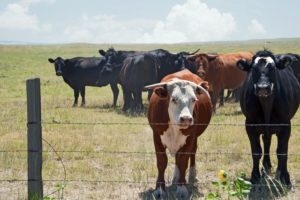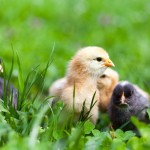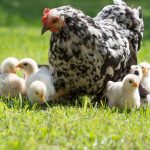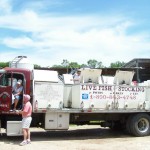
Traditionally, grazed forages provide beef cows the majority of their nutrients during the spring and summer months. However, during droughts when forage production stops, alternative feeds and feeding programs need to be utilized until forages are growing again. When deciding on an alternative feeding program for drought-stressed beef cattle herds, there are several options to consider. The goal is to get the cows re-bred, maintain pounds produced per cow, and minimize feed cost per pound of calf sold. Daily feed costs are going to increase during a drought. Options to consider are feed availability, equipment needs, and storage. The ideal alternative feeding program will meet the cows’ requirements as close to normal pasture costs as possible. Keeping cows in good body condition is very important for getting them re-bred. When body condition scores drop below 4, reproduction efficiency drops resulting in more open cows, longer calving intervals and less value in calf crop due to younger, lighter calves next year. In most herds, weaning weight drops 45-60 pounds for each heat cycle the cow does not calve. Based on $1.25/lb calf prices, the calf’s value will decrease $60.00 for each heat period the cow is not bred. In addition, fetal programming information shows that starving cows or “roughing them through” the drought will have lifetime lasting effects on the developing the fetus. We have to feed these cows to maintain body condition and production.
As forage availability becomes more limited, it may be necessary to cull some of the older or lower producing cows. Cows that are least likely to make a profit or will produce the fewest calves once the drought is over should be culled. Culling cows early will enable the ranch to concentrate on more intensive management strategies and maintain the productive cows though out the drought.
As forages become limiting, the first strategy to reduce forage consumption is to wean the calves. This strategy will decrease the nutrient requirements for the cows, help conserve cow body condition, and reduce forage demand. When early weaning (calves less than 150 days of age) it is important to provide access to a palatable high-quality starter. Accuration Starter LW and SteakMaker IM Starter LW are designed to get young calves on feed quickly, reduce health issues and allow them to grow at their genetic potential. Once calves are started on feed and over the stresses of weaning, the calves should be moved to the one of the Accuration/Cattle Limiter or Grow Gest feeds along with small amounts of forages. If no forages are available then the calves should be fed Impact Beef Grower or the IM Finisher diets.
Once the calves are weaned, reducing cow requirements as much as possible, we need to look at forage availability and quality. If adequate amounts of low-quality forage are available, choosing the correct supplement is critical. The free choice IM Technology products including Accuration Range 33, Accuration Cattle Limiters, Accuration Forage Extender, Sup-R-Blocks, Sup-R-Lix, RangeLand Ration Manager, or RangeLand and Purina Lix low moisture blocks can all be used to supplement low quality forages. These supplements are designed to increase forage utilization and digestibility to allow the cows to get more nutrients from the low-quality forages. They will enable cows to maintain body condition on low-quality forages in a convenient, cost-effective manner. However, care must be taken to ensure there is adequate forage available for these products.
If forage is not available or is to be fed in limited supply, a different feeding strategy must be used. The most common method of getting a cow herd through a period of very limited forage availability is to hand feed energy supplements. Lower protein cow cubes fed at 7 to 10 pounds is a common method to get cows through a drought period in herds with few feeding facilities. In addition, if feeding facilities are available high energy grain mixes can also be used. For example, cracked corn can be fed at 0.5 to 1.0% of body weight along with1-2 pounds of protein supplement (>30% CP) and hay at roughly 0.5% of body weight. Use of STEAKMAKER 40-20 R 400 or Cattle Finisher 40 which contain protein from NPN sources in addition to Rumensin to fortify grain-based rations will help increase rumen efficiency of limit-fed cows. When starting a limit-feeding program the cows need to be stepped up over a minimum of one week and stay on the same feed delivery schedule every day, just like feedlot cattle. If no forages are available, producers can use stocker/grower or shipping conditioner/hay stretcher products along with a free choice mineral to try and keep the cows in body condition. When corn is priced at $7.00 per bushel, 40% protein supplement around $350/ton and hay at $150 per ton, a limit-fed diet would be priced around $2.15 per cow/day. This will increase feed costs over a 4-month period around $200 per cow over that of a traditional grazing program with free choice mineral.
If no forages are available, the use of commodity feeds can also help to reduce feeding costs during a drought. The following feedstuffs can be used to decrease the dependency on forages and can be considered depending on local availability.
Cottonseed Hulls: Cottonseed hulls have been used as an excellent alternative to feeding hay in many parts of the country. Unlike most by-products, they can be used as the only source of roughage. Cottonseed hulls are low in protein (3.5%) but are equal in energy to late cut hay.
Soybean hulls: The crude protein in soybean hulls ranges from 10 to 16 percent. They are an excellent energy source in the form of highly digestible fiber.
Wheat middlings: Midds are a good source of protein (18%) and energy. The energy available in middlings is in the form of both starch and highly digestible fiber. Because of the starch in midds, it is not a good idea to feed midds without any additional roughage.
Corn gluten feed: Corn gluten feed is high in protein (25%), with 2/3 of the protein being rumen degradable. When corn gluten feed is fed at 0.5 percent of body weight with forage, the energy value is equivalent to or greater than that of corn grain. Corn gluten feed is available in wet (30-60 percent dry matter) or dry form (90 percent dry matter). The dry form is preferred because it is easier to transport, handle and store for cow-calf operations. The wet form can mold and rot in 3-14 days, depending on temperature and storage conditions.
Corn Distillers grains: Distillers grains are high in digestible fiber, protein, and energy. Like gluten feed, it is available in wet or dry forms, with dry being the preferred method due to storage limitations. It can be successfully added to cow diets to replace most of forage. However, because distiller’s grains are a product of a fermentation process, it is relatively low in degradable protein, so care must be taken to ensure rumen protein requirements are met.
When feeding cattle during a drought, here are a few items to keep in mind:
- Lack of adequate water. During a drought be sure to watch natural water sources such as ponds and tanks, to be sure there is adequate quality water available.
- Type and source of forage supplement are critical. If using low inclusion rate supplements, like IM Technology or low moisture blocks, make sure forage supplies are adequate. Remember, these types of feeds are designed to be forage supplements. If forage supply is limited, these products cannot work as designed.
- Hay cut under moisture stress conditions, especially sorghum type hays, may contain high levels of nitrate and prussic acid. If in doubt, it would be good to test for nitrate before feeding such hays, especially before feeding large amounts. Producers who cut drought corn or sorghum for hay are encouraged to check nitrate levels before feeding. Be sure to take a good representative sample when sending to the laboratory for analysis.
- Cattle grazing short pasture are more likely to consume toxic plants. Talk to your local extension agent or forage specialist for toxic plant potential in your area.
- Low diet digestibility and reduced intake may result when cattle receive inadequate protein (less than 7% to 8% CP in total diet) from low-quality forage such as drought pasture or forage substitutes such as peanut hulls, straws or gin trash.
- Feed only the most productive cows in the herd. When forages are limited and feed costs increase, feeding fewer more productive cows is a sound economic strategy.
When evaluating any alternative feeds proper nutrient balance is important. For example, many byproducts are high in phosphorus and care should be taken to ensure that the mineral needs are met as well as properly balanced in the total diet. Consult your Land O’ Lakes Purina Feed representative for help in balancing rations and considering the best solution for your feeding program.
Ted Perry, Beef Nutritionist
Land O Lakes Purina Feed
Example Rations for Drought Feeding
Stop by your local Farmers Coop and together we’ll map out a feeding program for your drought stressed beef cattle herd. With locations in the River Valley and NW Arkansas, we’re sure to have a location near you.



